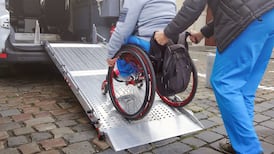It may seem premature to be considering a plan to reopen nursing homes to visitors with the daily Covid-19 death toll – mostly involving nursing home residents – still in double figures, but the sector’s regulator thinks this discussion needs to begin.
The Health Information and Quality Authority (HIQA), which inspects nursing homes, has raised the issue with Minister for Health Simon Harris and on the State's National Public Health Emergency Team (NPHET). HIQA chief executive Phelim Quinn is a NPHET member.
"It is time to start the conversation; we are not saying that it is happening today or tomorrow," said Susan Cliffe, deputy chief inspector at HIQA.
The topic has come up during the regulator’s 93 on-site assessments of nursing homes since mid-April, reviews aimed at assessing the preparedness of homes to manage an outbreak.
One HIQA inspector was told of the toll the lockdown was taking on elderly residents who had not had a visit in two months.
“The provider said that if they don’t die of Covid they are going to die of loneliness. That was a genuine concern,” said Cliffe.
There had to be a discussion around “how are we going to open the centres safely to visiting, however limited that is”.
She said among the solutions being considered was the installation of Perspex glass and “prison-type visiting scenarios”.
“What we want is a coherent approach to this that is risk-assessed, safe for the provider, safe for the residents, and safe for the relatives who are coming into the visit,” said Cliffe.
Mass testing
The HSE said on Sunday it had completed the mass testing of 28,000 residents and 30,000 staff across all 577 nursing homes in the State, and it had found confirmed or suspected coronavirus outbreaks in 371 or 64 per cent of nursing homes, far higher than previously thought.
However, the crisis in nursing homes – the worst-hit sector – appears to have peaked; the HSE said the number of nursing homes “of significant concern” had fallen to 56 from 90 in a week.
During the pandemic HIQA has escalated concerns to the HSE’s crisis management teams about outbreaks and testing delays (or no testing), along with shortages of staff, personal protective equipment (PPE) and oxygen at the worst-hit homes.
Cliffe says HIQA has received “a few snipey comments – ‘too little, too late’ is a common one” – but she could count the criticisms on “one hand”.
It listened “to the panic out there” without having “assets or the ability to sort problems, and can only look to pass the information on”, she said.
Cliffe talked about the “blind panic and the pandemonium” that gripped some homes as they fought outbreaks and managed multiple deaths after the first nursing home case of Covid was reported to HIQA on Monday, March 16th.
She believes the initial response was hampered by there being no relationship between the HSE and the 80 per cent of the homes that are privately owned.
She said some homes had a higher expectation of how the State would help and that State officials initially saw homes as independent legal entities.
She stressed, however, that these residential centres were “homes” and “never established to work as acute healthcare facilities”.
There was “an acceptance” within the HSE – around the start of the last week in March – that “the capacity just wasn’t there” to manage the deepening crisis, and she remembers a call from one Dublin home that was struggling to cope.
Significant deaths
“That nursing home was probably the third or fourth in the Dublin area that had significant deaths, but the number of deaths as a proportion of the overall residents is very high,” she said.
Cliffe expressed surprise at the large number of asymptomatic Covid-19 positive cases found in the mass testing, based on anecdotal reports. One home, which thought it was Covid-free, had 27 asymptomatic cases. In another all but four of the 40 residents were positive and asymptomatic.
Now HIQA believes there needs to be “an articulated plan” for retesting to get staff confirmed negative and back to work as nursing homes were still experiencing details in getting results.
“We need to move to a situation where centres have the capacity to do their own test, have access to a lab to send those tests, and have a coherent pathway to get those tests back in a timely fashion – I mean in 24 or 36 hours; I don’t mean five or six days,” said Cliffe.











